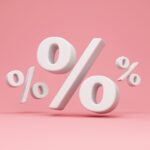It was widely expected that the first quarter of 2023 would have seen the world economy falling into a recession. As often happens, expectations are being disattended and the last economic data point to an economy that is more resilient than we could have expected.
This is mainly due to the delayed effect of fiscal stimulus that the government put in place during the pandemic and to a considerable strength of the labour market, where companies are reluctant to fire nonspecialized workers that became so difficult to find during the last period.
The scope of this post is not however to explain the economic causes of a stronger economy, but rather to investigate the different effect of these circumstances on the Savings Portfolio and on a conventional bond portfolio.
Table of contents
ToggleExpected ECB interest rates are now higher
The stronger economic data, coupled with inflation data also higher than expected, have produced an increase in the level of interest rates that is expected to materialize in the future.
Usually, in fact, when inflation rises, central banks hike interest rates. This tends to slow down the economy and the resulting decrease in demand usually contain the upward pressure on prices.
The graph below shows the ECB official interest rates expected today (in green) compared to the rates that were expected to the beginning of the year (in yellow).
So, official interest rates set by the European Central Bank are expected to rise in the future and somewhat more than expected, up to a ceiling of 4% (0.4% more). And also, therefore, the expected average yield that our Savings Portfolios can obtain in the coming years following the previous estimate of the variable yield of the Euro Savings Portfolio 2023/2025 that we have already described.
| Concepts/Years | 2023 | 2024 | 2025 |
| ECB average implicit interest rate level (1) | 3.00% | 3.75% | 3,25% |
| Estimated average variable yield Savings Portfolio (x year) (2) | 2.50% | 3.25% | 2.75% |
| Accumulated profitability (3) | 2,50% | 5.83% | 8.74% |
| March 2023 average yield estimate at the end of each year (4) | 2,50% | 2,87% | 2,83% |
| December 2022 estimated average yield at the end of each year (4) | 1,50% | 2,39% | 2,47% |
| Difference over previous estimate (5) | +1,00% | +0,48% | +0,36% |
As we can see in the table above, the average yield over the 3 years (2023, 2024, 2025) could now reach 2.83% against the 2.47% previously estimated, or 0.36% more.
Typically, this mean that bond prices will go down due to the inverse relationship between bond prices and interest rates that we described in this post. How much the price falls is defined by the duration of the bond, which measure its sensitivity to interest rates moves. Usually, longer maturity bonds fall more for a defined increase in interest rates.
It often happens that the yield of longer bonds does not move exactly in line with official central bank rates, but anyway, as a general rule, higher interest rates mean lower bond prices, so a conventional portfolio might see its value to decrease.
inbestMe Savings Portfolios have no interest rate risk
What happens to the Savings Portfolio? These portfolios are built with instruments that have basically zero or anyway very short duration. This means that a higher rate has a minimal impact on the prices of the instruments that compose the fund. When central banks hike rates, it simply means that a higher return will accrue on the portfolios (see the concept of variable yield).
Basically, there will not be any adverse effect on price, but just a higher rate of interest being earned.
What about bond portfolios?
Does all the above mean that we should sell our conventional bonds in the portfolio when rates are expected to rise and just go to the Savings Portfolios?
No, we can say that traditional portfolios are for long term investors. It may happen that higher interest rates put some pressure on bond prices, but long term portfolios need bonds to stay diversified. It is true that now interest rates are expected to rise, but economic conditions keep changing all the time and the future is impossible to foresee. So long term investors still require a balanced portfolio.
The Savings Portfolio is ideal for an emergency fund
What about the Savings Portfolio, then?
They are the ideal portfolios to keep those funds that can be considered as a safety account. Beside traditional, long term portfolios that are aimed to grow wealth over the long term, every family is strongly advised to keep a sort of safety account that should be enough to cover 2 years of expenses and may vary according to individual circumstances. Whatever unexpected happens, we should have an account that is easy to liquidate in case of need and that it is not exposed to market volatility.
Let’s consider the current economic situation, in which rates might increase further.
In the view of a long term investing portfolio, this is not going to be a big problem. Yes, we could see prices going down somewhat, but this is going to be irrelevant over the long term. The most important thing is keeping a portfolio well diversified that is able to cope with all the economic situations we will face over the years.
For the safety account is different. This is money that I might need if something unexpected happens to me or to my family. I do not want to be exposed to the possibility of having to liquidate these funds when their value is lower because of higher interest rates. That would translate into a real loss. That is why keeping your safety funds into an account that now gives you a decent return and is not exposed to market gyrations might be a very good idea, especially knowing that its expected yield may now be higher and reach an average above 2.5% (2.83%) over the next three years if the forecasts we have reviewed above are met.
On the other hand, don’t forget that no matter how high the yield of the Savings Portfolio rises, it will hardly exceed inflation. To beat inflation and achieve your financial goals you should consider investing with longer horizons and a higher risk profile. The most important risk is not meeting your financial goals.
The most important risk is not meeting your financial objectives.
Annex I: more details on the concepts used in the new table of the Savings Portfolio yield estimation:
- Implicit interest rate level (ECB): this is the implicit interest rate of the European Central Bank’s (ECB) monetary policy.
- Estimated average variable yield Savings Portfolio (x year) : equals (1) – 0.5%. We estimate that 0.5% should cover all costs and deviations within a few weeks of rate changes and is our target benchmark. This 0.5% could be somewhat higher if this is not the case.
- Cumulative return: is the cumulative return at the end of each year, i.e., at the end of 2025, e.g., Cumulative return 2025=(1+ yield 2023) X (1+ yield 2024) X (1+ yield 2025) -1
- Estimated average yield at the end of each year, new and prior: For example, at the end of 2025, the average yield at the end of each year = (1+Cumulative Return 2025)^(⅓)-1.
- Difference over previous estimate: this is the difference between the estimate made in December 2022 and the new estimate. Both are subject to change based on the interest rates definitively set by the ECB.
In this link, you can consult the updated yield of the Savings Portfolios.








